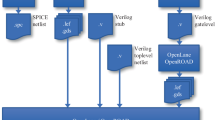Abstract
Multi-standard transceivers are more useful than the other classical transceivers. The flexibility of the multi-standard transceivers allow all pre-defined protocols to sense without redesign the transceiver in the RF front end. Multiple standard transceivers are used not only global markets but also military applications. Frequency agile filter is one of the basis element of multi-standard transceivers and some encryption techniques as frequency hopping spread spectrum (FHSS), DHSS. Some military applications (HAVE QUICK, SINCGARS, etc.) benefit from FHSS and direct-sequence spread spectrum to encode secret information by modulating different and arbitrary carriers. Such a technique needs frequency agile filters to detect signals modulated with different carriers. There are several methods to design frequency agile filters. In this work, current differencing trans-conductance amplifier (CDTA) is used for frequency agile filter design. Current differencing trans-conductance amplifier (CDTA) can be considerable alternative building block of current mode operational amplifiers. The circuit description of CDTA is very suitable to design analog filters by using only capacitors. A new reconfigurable filter employing CDTAs for analog signal processing is proposed in this paper. The filter structure consists of CDTAs as active element and only two capacitors as passive element. The designed filter operating range is applicable for different GPS protocols to implement on the same chip, SINCGARS (single channel ground and airborne radio system) and filtering IF signals. The filter is designed with AMS 0.18 µm technology. The filter performance is tested and verified by simulations with Cadence environment.























Similar content being viewed by others
References
Lakys, Y., & Fabre, A. (2013). Multistandard transceivers: State of the art and a new versatile implementation for fully active frequency agile filters. Analog Integrated Circuits and Signal Processing, 74(1), 63–78.
Lakys, Y., Godara, B., & Fabre, A. (2011). Cognitive and encrypted communications: State of the art and a new approach for frequency-agile filters. Turkish Journal of Electrical Engineering & Computer Sciences, 19(2), 251–273.
Mitola, J. (1995). The software radio architecture. Communications Magazine, IEEE, 33(5), 26–38.
Mak, P. I., Seng-Side, U., & Martins, R. P. (2007). Transceiver structure selection: Review, state-of-the-art survey and case study. IEEE Circuits and Systems Magazine, 7(2), 6–25.
Kountouris, A. A., Moy, C., Rambaud, L., Le Corre, P. (2001). A reconfigurable radio case study: A software based multi-standard transceiver for UMTS, GSM, EDGE and Bluetooth, in vehicular technology conference, 2001. VTC 2001 Fall. IEEE VTS 54th, (vol. 2, pp. 1196–1200).
Armagan, E., Kuntman, H. (2013). Configurable frequency agile filter application of balanced differential pair based CCCII circuit in 28 nm process, Proceedings of LASCAS 2013: 4th IEEE Latin American symposium on circuits and systems (CD), Cusco, Peru, February 27–March 1.
Harney, A., & O’Mahony, C. (2006). Wireless short-Range devices: Designing a global license-free system for frequencies <1 GHz. Analog Dialogue, 40(1), 18–22.
Sorin, M. Schwartz, frequency hopping spread spectrum (FHSS) versus direct sequence spread spectrum (DSSS) in broadband wireless access (BWA) and wireless LAN (WLAN), white paper.
Xu, X., Zhou, S., Morozov, A. K., & Preisig, J. C. (2013). Per-survivor processing for underwater acoustic communications with direct-sequence spread spectrum. The Journal of the Acoustical Society of America, 133, 2746–2754.
Ferri, G., & Guerrini, N. C. (2003). Low-voltage low-power CMOS current conveyors. Dordrecht, AH: Cluwer Academic Publishers.
Biolek, D. (2003). CDTA-building block for current-mode analog signal processing. Proceedings of the ECCTD’03 (Vol. III, pp. 397–400). Cracow, Poland.
Kacar, F., & Kuntman, H. H. (2011). A new, improved CMOS realization of CDTA and its filter applications. Turkish Journal of Electrical Engineering & Computer Sciences, 19(4), 631–642.
Alaybeyoğlu, E., Güney, A., Altun, M., & Kuntman, H. (2014). Design of positive feedback driven current-mode amplifiers Z-copy CDBA and CDTA, and filter applications. Analog Integrated Circuits and Signal Processing, 81(1), 109–120.
Alaybeyoglu, E., Kuntman, H. (2015). A new reconfigurable filter structure employing CDTA for positioning systems. In Electrical and electronics engineering (ELECO), 2015 9th international conference, (pp. 37–41, 26–28).
Arbel, A., & Goldminz, L. (1992). Output stage for current-feedback amplifiers, theory and applications. Analog Integrated Circuits and Signal Processing, 2, 243–255.
Altun, M., & Kuntman, H. (2008). Design of a fully differential current mode operational amplifier with improved input-output impedances and its filter applications. AEU: International Journal of Electronics and Communications, 62(3), 239–244.
Yuce, E., Kircay, A., & Tokat, S. (2008). Universal resistorless current-mode filters employing CCCIIs. International Journal of Circuit Theory and Applications, 36(5-6), 739–755.
Yuce, E., & Minaei, S. (2008). On the realization of high-order current-mode filter employing current controlled conveyors. Computers & Electrical Engineering, 34(3), 165–172.
Pandey, N., Pandey, R., Choudhary, R., Sayal, A., & Tripathi, M. (2013) Realization of CDTA based frequency agile filter. Signal processing, computing and control (ISPCC), 2013 IEEE international conference (pp. 1–6), Solan.
Author information
Authors and Affiliations
Corresponding author
Rights and permissions
About this article
Cite this article
Alaybeyoğlu, E., Kuntman, H. A new frequency agile filter structure employing CDTA for positioning systems and secure communications. Analog Integr Circ Sig Process 89, 693–703 (2016). https://doi.org/10.1007/s10470-016-0770-9
Received:
Revised:
Accepted:
Published:
Issue Date:
DOI: https://doi.org/10.1007/s10470-016-0770-9




